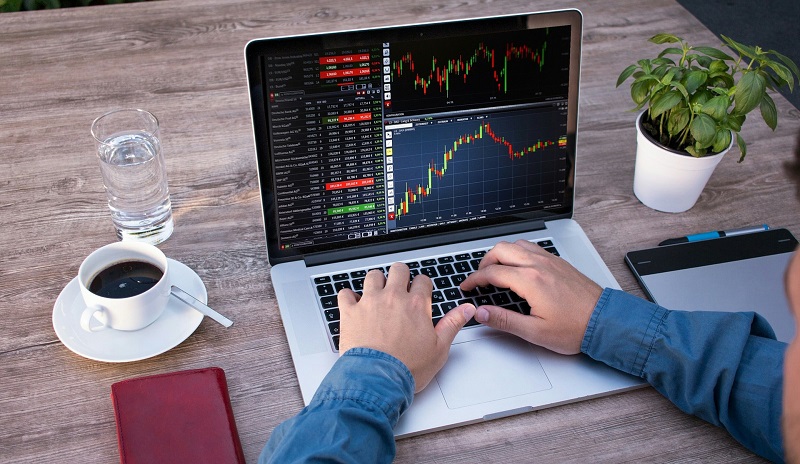
Forex trading in USA
What exactly is Forex trading? Forex trading in the U.S comprises the buying and selling of multiple currencies. You gain from the difference in the price of when you buy and when you sell it.
Beginners in forex trading make use of certain foundational concepts of stock trading. However, the main difference is stock trading involves trading stocks, where forex trading involves trading currencies.
Content
- What does trading currencies imply?
- The advantages of forex trading are as follows;
- Forex Trading Hours In USA
- What Is The Best Day For Forex Trading?
- Taxes on Forex Options and Futures Traders
- The tax calculation for over the counter (OTC) investors
- How to verify a broker’s regulatory status
- Is the Broker Regulated?
- Are the Fees Affordable?
- Which FX Pairs are Available?
- Which Deposit/Withdrawal Methods are Accepted
- Additional Factors to Consider
- What Forex Trading Platform Should You Use?
- US Investors Looking to Trade Overseas
- Differences in Forex Trading in the US
- Some Useful Tips To Know Before Embarking On Forex Trading;
- Find Out What You Want To Achieve And Work Towards It
- Conclusion
What does trading currencies imply?

Let us take a look at a real-world example – Forex trading takes place in currency pairs, which means if you find that the USD is cheap at a given point in time, you can sell the Euro and buy the USD. You would then like to sell the USD at a higher price after profiting from the sale of the Euro.
Why are some of your friends trying to convince you to start trading Forex? The reasons are not too far-fetched as you think!
The advantages of forex trading are as follows;

Low entry requirements: We have seen how money and a big difference in income can affect the decision to start or not start a company. However, it is not the case when it comes to Forex Trading. Several brokers allow you to start trading with as little as $100!
See what I mean? It is manageable
Low-risk potential: Usually, people would think that money can easily be lost when you trade Forex. However, that is not the case if you work smartly while trading, with only micro-lots. You will be in control of your risk when you do it this way – small trade will result in small losses. You can’t lose more than what you expect as the Forex market is not like the stock market, full of gaps.
Enter and exit positions with no harm: Do you know that the Forex market is the largest in the world? Allegedly, trillions traded every day. There are no limitations to the number of trades you can do. You can enter and exit trades as much as you like while still not harming your positions.
Low processing fee: There is one major difference between forex brokers and stockbrokers. You will get charged for transaction fees when you do stock trading while several forex brokers don’t.
Unrestricted Trading hours: One other advantage you get in forex trading is that you can trade 24/7 including weekends. You can get this when you do stock trading.
Forex Trading Hours In USA

Forex Trading platforms in the U.S facilitate orders 24/7. It is recommended that beginners stick to the most active market hours which is 0930hrs-1600hrs. This is to ensure that you can benefit from higher trading volumes within a less volatile space.
Frankfurt, London, New York, Sydney, and Tokyo are the global exchange markets that regularly open and close over a trading week.
You can trade online 24 hours a day, 7 days a week, or 24 hours a day, 5 days a week, depending on your preferences. When the American, U.S, and European markets are open for business, the forex market is at its busiest.
If you trade during these periods of increased liquidity, your broker is likely to offer tighter spreads on your forex trades. The U.S market opens 0930hrs-1600hrs daily.
What Is The Best Day For Forex Trading?

The best day to trade Forex is typically the day when the market is most volatile. This is since the quicker it goes, the more trading opportunities you will have. As you can see from the chart below, the best days to trade are Tuesday, Wednesday, and Thursday.
Taxes on Forex Options and Futures Traders
For tax purposes, forex options and futures contracts are classified as IRC Section 1256 contracts. As a result, they are subject to a 60/40 tax split. It means that 60% of your gains or losses will be classified as long-term capital gains or losses, while the remaining 40% will be classified as short-term capital gains or losses.
Important things to keep in mind:
- Before beginning to trade forex, aspiring forex traders should think about the tax implications.
- The 1256 contracts that makeup forex futures and options will be taxed according to the 60/40 policy. Long-term capital gains will account for 60% of gains or losses, while short-term capital gains will account for 40%.
- Spot forex traders classify as 988 traders, and their losses are deductible.
- Currency traders can choose between standard commodities 1256 contracts and the special rules of IRC Section 988 for currencies in the spot forex market
With these guidelines in mind, it’s also important to note that a 60/40 tax treatment is typically more advantageous for people in higher income brackets. Investors that trade futures or options pay the full long-term capital gains rate (or 20% on 60% of the gains or losses) as well as the maximum short-term capital gains rate (or 37 per cent on the 40 per cent).
The tax calculation for over the counter (OTC) investors
The vast majority of spot forex traders are subject to IRC Section 988 taxation. These are for foreign exchange transactions that are concluded within two days, allowing them to be treated as ordinary losses and profits.
If you are a spot forex trader, you are most likely classified as a 988 trader. So, if you lose money as a 988 trader at the end of the year, you will get great benefits. It means that, as in the 1256 contract category, you will treat all of your losses as ordinary losses rather than only the first $3,000.
When it comes to forex taxes, there are a few points to keep in mind. They are as follows:
- Keep in mind the deadline: In most situations, you must choose a tax situation by January 1 of each year. If you’re new to forex trading, you should make this decision before you place your first trade at any time.
- Good record keeping – Keeping good records can save you a lot of time during tax season. It means you can spend your time trading rather than rushing around keeping your paperwork in order.
- Pay the taxes – Some traders try to get ahead of the game by not paying taxes on their forex trades. Since over-the-counter trading is not controlled by the Commodities Futures Trading Commission they believe they can get away with it (CFTC). You should, however, be aware of the situation and pay your taxes on time. Even if you think you’ll get away with it, the IRS will finally catch up with you, and you’ll end up paying far more in fines than you owe in taxes.
Take the time to prepare your taxes properly, whether you want to make forex trading your profession or just dabble in it. It will save you hundreds, if not thousands, of dollars in fines. Taxes must be paid, and the procedure is well worth the time.
Key Provisions of U.S. Regulations:
- Individuals with assets of less than $10 million and most small companies” are classified as customers, emphasizing that these rules are designed to protect small investors. Standard regulated forex brokerage accounts may not cover high-net-worth individuals.
- On the major currencies, available leverage is limited to 50:1 (or a deposit threshold of just 2% of the notional value of a forex transaction) to protect uneducated investors from taking unheard-of risks. The British pound, Swiss franc, Canadian dollar, Japanese yen, euro, Australian dollar, New Zealand dollar, Swedish krona, Norwegian krone, and Danish krone are all examples of major currencies.
- On minor currencies, available leverage is limited to 20:1 (or 5% of the notional transaction value).
- The notional transaction value plus the option premium earned should be held as a security deposit for short forex options.
- The entire option premium is required as protection for long forex options.
- The first-in-first-out (FIFO) rule prohibits traders from holding multiple positions in the same forex asset at the same time. This means that every open exchange position (buy/sell) in one currency pair is squared off with the opposite position (sell/buy) in the same currency pair. This also means that hedging is not an option when trading forex.
Money owed by a forex broker should only be deposited in one or more eligible institutions in the United States or money-centre countries.
This is a list of forex brokerage regulators for a few select countries;
- United Kingdom – Financial Services Authority (FSA )
- Australia – Australian Securities and Investments Commission (ASIC )
- South Africa – Financial Sector Conduct Authority (FSCA )
- Switzerland – Swiss Federal Banking Commission (SFBC )
- Cyprus – Cyprus Securities and Exchange Commission (CySEC )
- Russia – Federal Financial Markets Service (FFMS)
How to verify a broker’s regulatory status
Background Affiliation Status Information Center (BASIC) is an online verification system run by the NFA that allows you to check the status of U.S.-based forex brokerage firms by entering their NFA ID, firm name, person name, or pool name. Since many forex broker firms are known to have different names, it’s important to use the correct name/ID in the correct form (e.g., a website name may be different from the legal corporate name).
Factors you should consider before choosing a forex trading broker in the US
Is the Broker Regulated?
When selecting a broker, we believe it is important to choose one who has been certified and licensed. Brokers are held accountable by regulatory bodies such as the CFTC for general requirements, consumer due diligence, and financial conduct. This makes the forex trading environment in the United States better for everybody.
Not only that but brokers are required to apply routine audits under SEA Rule 15c3-3 (Securities Exchange Act).
CFTC-approved brokers are often required by law to keep your money in a separate account from their own. This protects you from bankruptcy and financial fraud to some degree.
Any online broker who holds a license can proudly show their license number on their trading website. Furthermore, you can always review the CFTC’s official website to ensure that the brokerage firm is accredited and licensed.
Here are the list for some of the regulated brokers in us;
Are the Fees Affordable?
We’ve gone through the different fees you can expect to pay while trading forex in the United States. You’ll find commission-free brokers (like Forex.com) as well as brokers that charge exorbitant trading fees.
At the end of the day, it’s up to you and your strategy/budget to decide which trading platform to use and how much risk you’re willing to take.
All we can say is that commission-free forex trading is available in the United States. All you have to do now is conduct your studies.
Low commissions, tight spreads on forex pairs, and access to a variety of markets are ideal. Also, keep an eye out for inactivity fines. Some brokers will charge you if you haven’t traded for six months.
These payments vary, but we’ve found that after the prescribed period of inactivity has passed, they typically range from $10 to $50 per month.
Which FX Pairs are Available?
Although this may seem self-evident, it’s pointless to sign up with a broker focused on low fees and a robust platform if they don’t sell the pairs you want to trade. You should consider not only the currency pairs you want to trade and whether or not they are eligible, but also how much variety the online broker can provide.
After all, you may want to trade big pairs right now but branch out into minors and exotics later.
Exotic pair markets are not available on all online trading sites. Before putting all of your forex trading assets in one bowl, do some research. Take note, Forex.com provides over 90+ pairs- including hundreds of exotic markets.
Which Deposit/Withdrawal Methods are Accepted
Each broker is unique. If you really must finance your account with a particular payment method, such as a debit card, make sure the broker accepts it.
It’s a good idea to double-check which payment options are open to you, as well as whether or not you’ll be charged transaction fees. Although it should be noted that transaction fees are not common among trading platforms. Those that do so almost always do so by using particular payment methods.
It’s worth noting that if you deposit money into your preferred forex platform via bank transfer, you can expect it to take two or three days to hit your trading account.
Additional Factors to Consider
Aside from the significant metrics we’ve mentioned here, there are a few other factors to consider when looking for the best forex broker in the United States;
- Is the broker’s website easy to access and use?
- Will I be able to access forex-related educational materials?
- Is technical or fundamental research accessible on the platform?
- Is the trading platform MetaTrader4 compatible?
- Is it possible to trade with my phone?
- Is it possible to use a trial account?
What Forex Trading Platform Should You Use?
To begin, what exactly is a trading platform? A Forex Trading platform is a piece of software that lets you draw lines, plot indicators, and display charts, among other things.
MT4 and TradingView are the two most common trading platforms so far.
Let’s take a look at TradingView first.
TradingView is the most recent Forex trading site on the market. It’s a cloud-based software.
Pros
- It comes with lots of trading instruments and indicators.
- It is free to use, and you can upgrade to gain access to additional functionality.
- There are a lot of maps and layouts that are descriptive.
- It includes Forex, cryptocurrencies, CFDs, and stocks, among other things.
Cons
- At any given time, it can only insert three indicators.
- The free edition has a lot of advertisements.
- It does not carry out trades with a large number of Forex brokers. It mostly just charts them.
MT4
MT4 is a famous trading platform that has been around for a long time. It is a web program, unlike Trading View, a desktop application
Pros
- It is fast.
- It’s costless.
- You have the option of directly executing trades on MT4.
Cons
- There are a few glitches in it, such as the “flying” trendline.
- It is unsupported.
- A few trading indicators are available. They are often required to be coded or downloaded from the internet.
In Conclusion, If you want to conduct all of your trades on the same board, MT4 is the way to go. TradingView is the way to go if you want extra features like indicators.
US Investors Looking to Trade Overseas
Due to the procedure and the strict conditions for trading overseas, things can get a little difficult for US investors who want to trade overseas. To be able to trade, you must first ensure that your broker is CFTC controlled.
Second, tax laws will make it more difficult for you. If you are based in the United States and trade internationally, you must pay taxes at the 60/40 rate. Even if you are trading internationally, you will not be excluded from paying taxes.
Differences in Forex Trading in the US
Because of the above-mentioned changes in rules, forex trading in the United States is slightly different.
The following are the key differences: Ban on hedging and leverage
Hedging
In a statement issued in 2009, the NFA confirmed a few new laws, including a prohibition on hedging with forex trading in the United States. This decision was made primarily to halt or prevent any chance of profiting from a transaction. So, don’t go bending the rules because it might cost you in more ways than one.
It is also worth noting that the FIFO (First in, First out) law has been updated. It is a condition for forex trading compliance. If you have several trades of the same pair and scale, it states that the first or oldest trade must be closed.
Leverage
Leverage rules for US forex brokers were also modified, and leverage ratios were reduced to 1:50 or 50:1. It means you can exchange $50 of a major currency for every $1 you spend, as well as 20:1 or 1:20 for a secondary pairing.
Forex trading is legal and possible in the United States. The most important thing to note is that you must follow US law and tax requirements when trading forex in the United States. It’s also a good idea to do a lot of studying and have plenty of practice with demo accounts before you start trading.
Best Forex Broker
Some Useful Tips To Know Before Embarking On Forex Trading;
You Won’t Get Rich Quick In Forex Trading
Technically, you might, but that is a dangerous mindset to have. Amateurs should unlearn that attitude, in my opinion. Trading Forex requires a great deal of flexibility and practice.
Do not fall for any scam scheme that promises you millions of dollars quickly when trading in Forex.
Also read : Forex Trainers Online
Take The Conservative Route
I am going to use a scenario to illustrate my point.
Let us assume that there are two traders. Michael and John are a couple.
John is a cautious investor who only loses 2% of his account per day.
Michael, on the other hand, is an aggressive dealer. Every day, he takes a 25% gamble on his account.
As it turns out, they both use a trading strategy that consistently wins 50% of the time. With an average risk-to-reward ratio of 1:2.
Also read : Best Forex Strategy for Consistent Profits
Here is the result of their individual next 8 trades.
Because the outcome was, Lose-lose-lose-lose-win-win-win-win.
So For John, it is
– 2% – 2% – 2% – 2% + 4% + 4% + 4% + 4% = +8%
For Michael it is
– 25% – 25% – 25% – 25% = BLOW UP
Can you see why taking the safe path is always the better option? You should aim for good risk management regardless of how good your trading system is.
Have A Good Trading Strategy
Forex Trading is like any other business endeavour. One must have a schedule and a strategy for carrying it out. Many inexperienced Forex traders get stuck because they never take the time to plan their trading strategy.
Also read: Triangle Pattern Forex
The following are some of the things to include in a well-detailed plan;
- The market in which you want to trade
- If you’re in a losing trade, how can you get out?
- The number of units you choose to purchase
- How to get out of a deal when you’re on the right track
- The sum of money you’re willing to put on the line in each exchange.
- Choose your entry trigger.
Find Out What You Want To Achieve And Work Towards It
People begin their careers as Forex traders with a range of objectives in mind. Each of these objectives requires a different strategy, which is why you must first identify your objective and then focus your energy on achieving it.
Intraday trading is the perfect option for those who want to trade for a living.
Systems Trading is the way to go if you want to trade vigorously with a lot of adrenaline rush. Just before the NFP, you can trade with 100 times leverage.
Swing trading is the way to go if you want to increase your net worth.
As you can see, having a clear understanding of the path you want to take is critical before you begin trading .
Conclusion
Trading forex in the U.S is an art form. You wouldn’t become an expert in a few days. It takes a lot of practice to get good at something.
The Forex trading market in the U.S is one of the most vibrant and active in the world. Here you will find a wealth of knowledge to help you with your learning. Open your mind and be able to put in the effort necessary to master trading.




